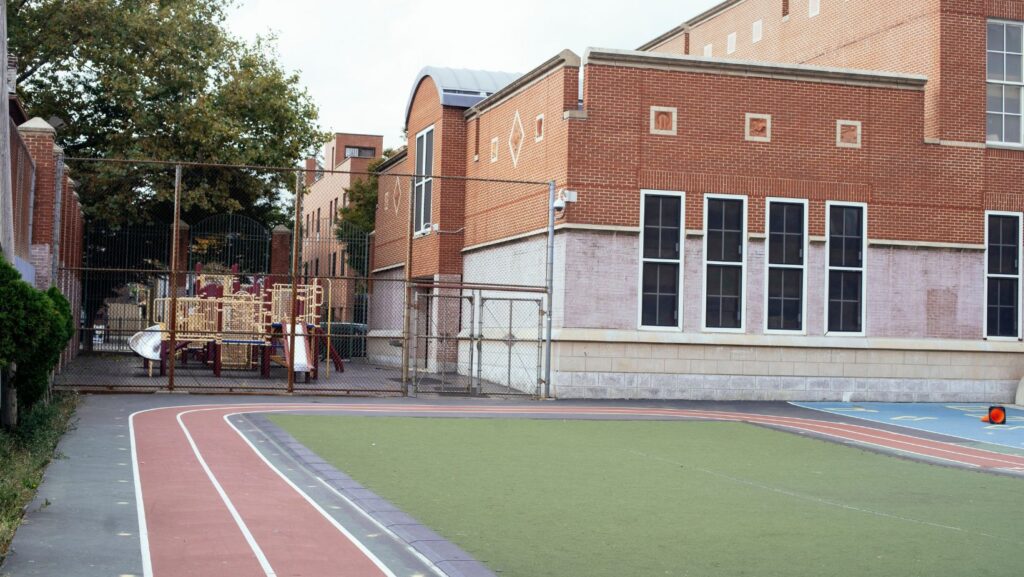
Research by the Centers for Disease Control and Prevention shows that at least 57% of high school students have played at least one sport.
So, if you own a school, you must plan good student facilities. These facilities will also enhance the status of your school!
Ensure good facilities for them to bring out their best version of sportsmanship. And to create the ultimate school sports field, consider these tips:
1. Plan Layout and Design
Identify the sports and activities that will be practiced on the field. Consider the requirements of each sport, such as field dimensions, markings, and equipment.
Determine the available space and allocate areas for different sports, warm-up zones, seating, and spectator areas.
Ensure each area is appropriately sized and positioned. Select flexible spaces that can accommodate multiple sports or activities. For example, a track can serve as a running area and a perimeter for field sports.
Plan pathways and entrances to ensure smooth movement of athletes, spectators, and officials. Consider factors like wind direction, sun exposure, and topography.
Incorporate school colors, logos, and branding elements into the field’s design for a unified and spirited look. Ensure your design adheres to local regulations, building codes, and safety standards for sports facilities.
2. Improve Turf Quality
Choose the appropriate type of turf based on your school’s climate, intended sports, and maintenance capabilities, like natural grass, hybrid grass, or synthetic turf. Prepare the soil by ensuring proper drainage, composition, and nutrient levels.
If using natural grass, consider installing sod for instant coverage and uniformity. Properly lay and compact the sod to eliminate gaps and air pockets. If using synthetic turf, work with experienced professionals to install it correctly.
Ensure proper base preparation, infill material, and drainage systems. Keep drainage systems clear and functional to prevent waterlogging and ensure quick water runoff during heavy rainfall.
3. Provide Safety Measures
Ensure the field layout considers safety zones, such as clear areas around goalposts, fences, and out-of-bounds boundaries.
Install appropriate fencing and high-quality Sports Netting to prevent unauthorized access and protect spectators from flying balls or equipment. Provide adequately maintained and safe sports equipment.
Keep the playing surface well-maintained to reduce the risk of trips, slips, and falls. Repair divots, holes, and uneven areas promptly. Inspect the field, equipment, and facilities regularly to identify and address potential safety hazards.
4. Install Proper Lighting Facility
Work with lighting experts to design a system that provides balanced light across the entire playing surface. Avoid shadows and dark spots.
Determine the appropriate lighting levels for different sports and activities. Install fixtures with proper shielding to reduce glare for players, coaches, and spectators.
Position light poles strategically to minimize shadows and obstructions. Ensure they are tall enough to cover the entire field without causing visual distractions.
Install timers and control systems that automatically turn the lights on and off based on scheduled game times or dusk-to-dawn settings.
5. Work on Seating and Spectator Areas
Determine the best locations for seating areas, considering factors like sightlines, accessibility, and proximity to the field—position seating to provide clear views of the action.
Estimate the expected number of spectators and design seating areas to accommodate the anticipated crowd size.
Design seating areas accessible to individuals with disabilities, including designated spaces for wheelchair users. Include covered seating areas or shade structures to protect spectators from sun and rain.
Integrate amenities like drink holders, cup holders, and tables for spectators to place belongings.
Position sitting areas near concession stands, restrooms, and other facilities to ensure convenience for spectators.
6. Enhance Landscaping and Aesthetics
Incorporate native plants, trees, and shrubs that thrive in your local climate. These elements not only beautify the area but also contribute to ecological balance.
Create a welcoming entrance with signage, plantings, and architectural features that reflect the school’s identity and spirit.

The landscape around seating areas with decorative plants and flowers adds color and softness to the space.
Define the edges of the sports field with attractive borders or edging materials that help separate different areas.
Install sculptures, art installations, or murals celebrating sports, teamwork, and school pride.
Conclusion
Remember to contact experienced professionals in the relevant fields for initial consultations. Discuss your vision, goals, and budget to gather insights and recommendations.
To create the ultimate school sports field, meticulously plan and collaborate. So, start connecting with the right people and suppliers once you’re ready and make your school reach its peak!















